stop start RENAULT ESPACE 2012 J81 / 4.G Owners Manual
[x] Cancel search | Manufacturer: RENAULT, Model Year: 2012, Model line: ESPACE, Model: RENAULT ESPACE 2012 J81 / 4.GPages: 267, PDF Size: 8.95 MB
Page 13 of 267
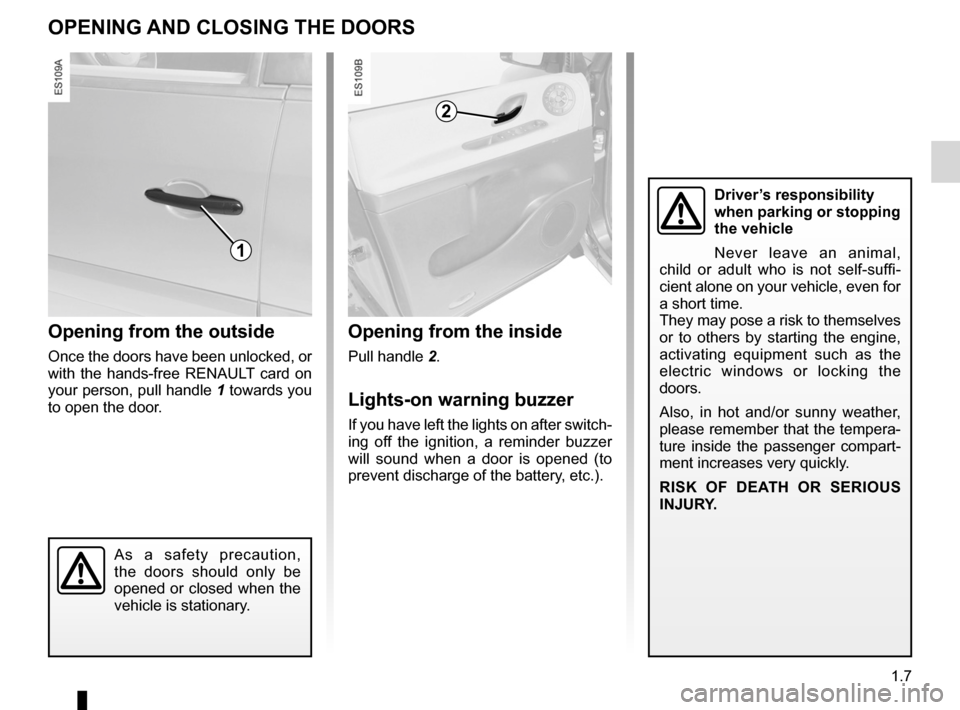
audible and visual signals......................................(current page)
central door locking .............................. (up to the end of the DU)
lights: hazard warning ................................................ (current page)
doors/tailgate ........................................ (up to the end of the DU)
locking the doors .................................. (up to the end of the DU)
RENAULT card use .................................................. (up to the end of the DU)
1.7
ENG_UD20324_1
Ouverture et fermeture des portes (X81 - J81 - Renault)
ENG_NU_932-3_X81ph3_Renault_1
Doors
OPenInG and cLOsInG THe dOOrs
Opening from the outside
Once the doors have been unlocked, or
with the hands-free RENAULT card on
your person, pull handle 1 towards you
to open the door.
Opening from the inside
Pull handle 2.
Lights-on warning buzzer
If you have left the lights on after switch-
ing off the ignition, a reminder buzzer
will sound when a door is opened (to
prevent discharge of the battery, etc.).
1
2
driver’s responsibility
when parking or stopping
the vehicle
Never leave an animal,
child or adult who is not self-suffi -
cient alone on your vehicle, even for
a short time.
They may pose a risk to themselves
or to others by starting the engine,
activating equipment such as the
electric windows or locking the
doors.
Also, in hot and/or sunny weather,
please remember that the tempera-
ture inside the passenger compart-
ment increases very quickly.
r Is K O f dea TH O r ser IOUs
InJUr Y.
As a safety precaution,
the doors should only be
opened or closed when the
vehicle is stationary.
Page 35 of 267
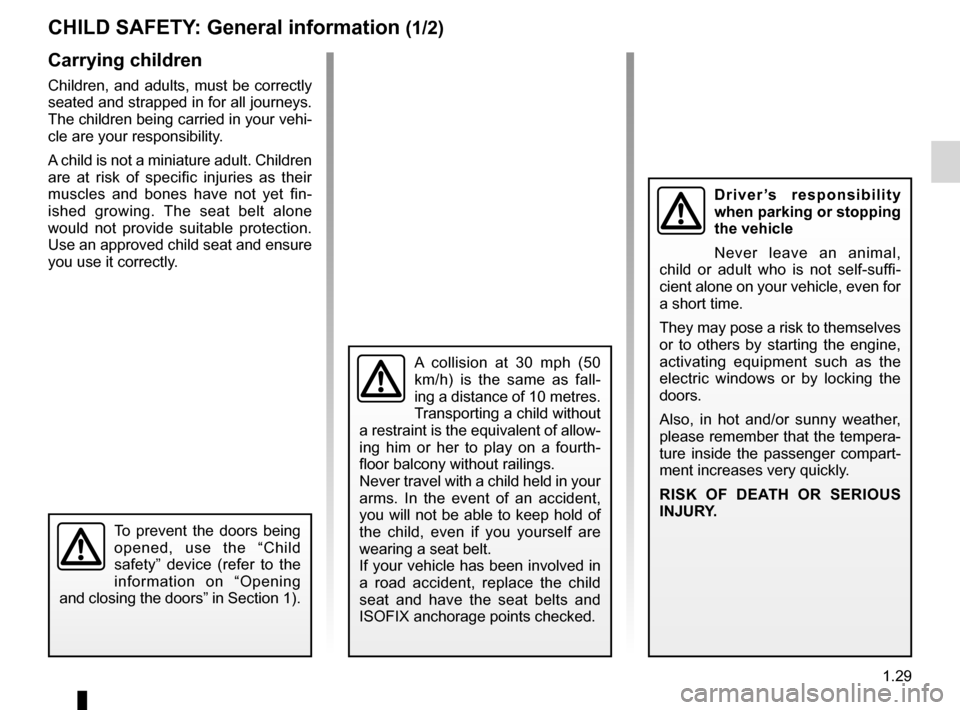
child safety............................................ (up to the end of the DU)
child restraint/seat ................................ (up to the end of the DU)
child restraint/seat ................................ (up to the end of the DU)
child restraint/seat ................................ (up to the end of the DU)
child seats ............................................. (up to the end of the DU)
transporting children ............................. (up to the end of the DU)
children ................................................. (up to the end of the DU)
1.29
ENG_UD18356_1
Sécurité enfants : généralités (X45 - H45 - L38 - X38 - \
X32 - Renault)
ENG_NU_932-3_X81ph3_Renault_1
Child safety: General information
cHILd safeTY : General information (1/2)
carrying children
Children, and adults, must be correctly
seated and strapped in for all journeys.
The children being carried in your vehi-
cle are your responsibility.
A child is not a miniature adult. Children
are at risk of specific injuries as their
muscles and bones have not yet fin -
ished growing. The seat belt alone
would not provide suitable protection.
Use an approved child seat and ensure
you use it correctly.
A collision at 30 mph (50
km/h) is the same as fall -
ing a distance of 10 metres.
Transporting a child without
a restraint is the equivalent of allow -
ing him or her to play on a fourth -
floor balcony without railings.
Never travel with a child held in your
arms. In the event of an accident,
you will not be able to keep hold of
the child, even if you yourself are
wearing a seat belt.
If your vehicle has been involved in
a road accident, replace the child
seat and have the seat belts and
ISOFIX anchorage points checked.
To prevent the doors being
opened, use the “Child
safety” device (refer to the
information on “Opening
and closing the doors” in Section 1).
d r i v e r ’s r e s p o n s i b i l i t y
when parking or stopping
the vehicle
Never leave an animal,
child or adult who is not self-suffi -
cient alone on your vehicle, even for
a short time.
They may pose a risk to themselves
or to others by starting the engine,
activating equipment such as the
electric windows or by locking the
doors.
Also, in hot and/or sunny weather,
please remember that the tempera-
ture inside the passenger compart-
ment increases very quickly.
r Is K O f dea TH O r ser IOUs
InJUr Y.
Page 49 of 267
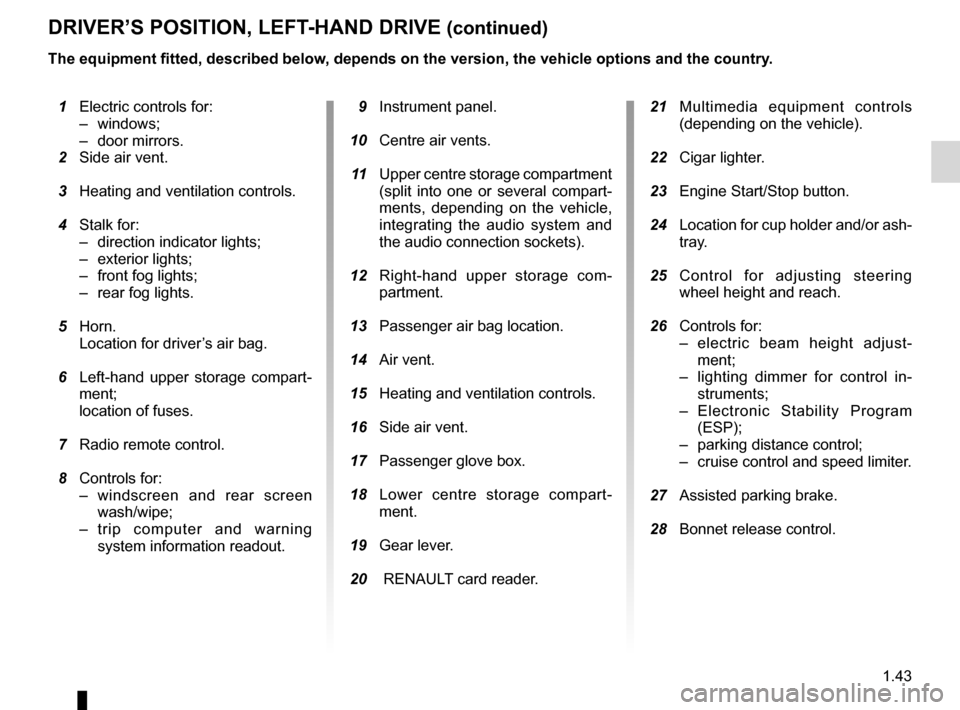
JauneNoirNoir texte
1.43
ENG_UD24086_2
Poste de conduite à gauche (X81 - J81 - Renault)
ENG_NU_932-3_X81ph3_Renault_1
drIVer’s POsITIOn, LefT-Hand drIVe (continued)
1 Electric controls for:
– windows;
– door mirrors.
2 Side air vent.
3 Heating and ventilation controls.
4 Stalk for:
– direction indicator lights;
– exterior lights;
– front fog lights;
– rear fog lights.
5 Horn.
Location for driver’s air bag.
6 Left-hand upper storage compart -
ment;
location of fuses.
7 Radio remote control.
8 Controls for:
– windscreen and rear screen
wash/wipe;
– trip computer and warning
system information readout.
9 Instrument panel.
10 Centre air vents.
11 Upper centre storage compartment
(split into one or several compart-
ments, depending on the vehicle,
integrating the audio system and
the audio connection sockets).
12 Right-hand upper storage com -
partment.
13 Passenger air bag location.
14 Air vent.
15 Heating and ventilation controls.
16 Side air vent.
17 Passenger glove box.
18 Lower centre storage compart -
ment.
19 Gear lever.
20 RENAULT card reader. 21 Multimedia equipment controls
(depending on the vehicle).
22 Cigar lighter.
23 Engine Start/Stop button.
24 Location for cup holder and/or ash-
tray.
25 Control for adjusting steering
wheel height and reach.
26 Controls for:
– electric beam height adjust -
ment;
– lighting dimmer for control in -
struments;
– Electronic Stability Program
(ESP);
– parking distance control;
– cruise control and speed limiter.
27 Assisted parking brake.
28 Bonnet release control.
The equipment fitted, described below, depends on the version, the vehicle options and the country.
Page 51 of 267
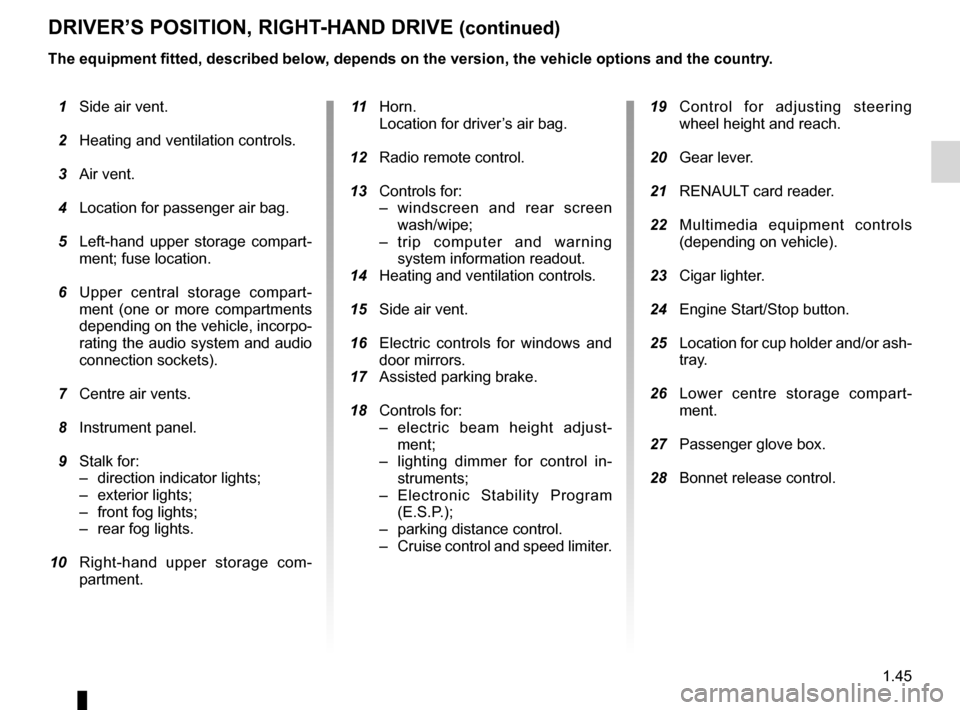
accessories socket ................................................ (current page)
JauneNoirNoir texte
1.45
ENG_UD24087_2
Poste de conduite à droite (X81 - J81 - Renault)
ENG_NU_932-3_X81ph3_Renault_1
drIVer’s POsITIOn, rIGHT-Hand drIVe (continued)
1 Side air vent.
2 Heating and ventilation controls.
3 Air vent.
4 Location for passenger air bag.
5 Left-hand upper storage compart -
ment; fuse location.
6 Upper central storage compart -
ment (one or more compartments
depending on the vehicle, incorpo -
rating the audio system and audio
connection sockets).
7 Centre air vents.
8 Instrument panel.
9 Stalk for:
– direction indicator lights;
– exterior lights;
– front fog lights;
– rear fog lights.
10 Right-hand upper storage com -
partment.
11 Horn.
Location for driver’s air bag.
12 Radio remote control.
13 Controls for:
– windscreen and rear screen
wash/wipe;
– trip computer and warning
system information readout.
14 Heating and ventilation controls.
15 Side air vent.
16 Electric controls for windows and
door mirrors.
17 Assisted parking brake.
18 Controls for:
– electric beam height adjust -
ment;
– lighting dimmer for control in -
struments;
– Electronic Stability Program
(E.S.P.);
– parking distance control.
– Cruise control and speed limiter. 19 Control for adjusting steering
wheel height and reach.
20 Gear lever.
21 RENAULT card reader.
22 Multimedia equipment controls
(depending on vehicle).
23 Cigar lighter.
24 Engine Start/Stop button.
25 Location for cup holder and/or ash-
tray.
26 Lower centre storage compart -
ment.
27 Passenger glove box.
28 Bonnet release control.
The equipment fitted, described below, depends on the version, the vehicle options and the country.
Page 52 of 267
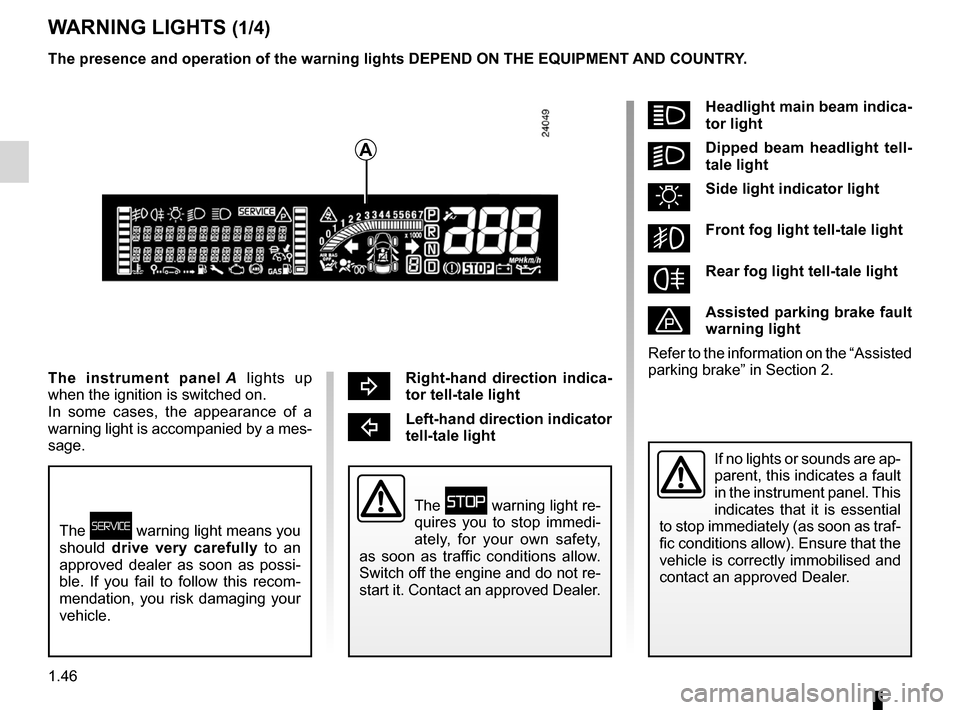
control instruments ............................... (up to the end of the DU)
indicators: instrument panel ............................. (up to the end of the DU)
instrument panel ................................... (up to the end of the DU)
warning lights ........................................ (up to the end of the DU)
display .................................................. (up to the end of the DU)
lights: fog lights .......................................................... (current page)
lights: dipped beam headlights ................................... (current page)
lights: direction indicators ........................................... (current page)
lights: main beam headlights ...................................... (current page)
indicators ............................................................... (current page)
1.46
ENG_UD20346_1
Tableau de bord : témoins lumineux (X81 - J81 - Renault)
ENG_NU_932-3_X81ph3_Renault_1
Jaune NoirNoir texte
bright-hand direction indica -
tor tell-tale light
cLeft-hand direction indicator
tell-tale light
Instrument panel
WarnInG LIGHTs (1/4)
áHeadlight main beam indica-
tor light
kd ipped beam headlight tell -
tale light
uside light indicator light
gfront fog light tell-tale light
frear fog light tell-tale light
Ãassisted parking brake fault
warning light
Refer to the information on the “Assisted
parking brake” in Section 2.
a
The instrument panel A lights up
when the ignition is switched on.
In some cases, the appearance of a
warning light is accompanied by a mes-
sage.
The ú warning light means you
should drive very carefully to an
approved dealer as soon as possi -
ble. If you fail to follow this recom -
mendation, you risk damaging your
vehicle.
The û warning light re-
quires you to stop immedi -
ately, for your own safety,
as soon as traffic conditions allow.
Switch off the engine and do not re-
start it. Contact an approved Dealer.
If no lights or sounds are ap-
parent, this indicates a fault
in the instrument panel. This
indicates that it is essential
to stop immediately (as soon as traf-
fic conditions allow). Ensure that the
vehicle is correctly immobilised and
contact an approved Dealer.
The presence and operation of the warning lights dePend On THe eQUIPMenT and cOUnTrY.
Page 53 of 267
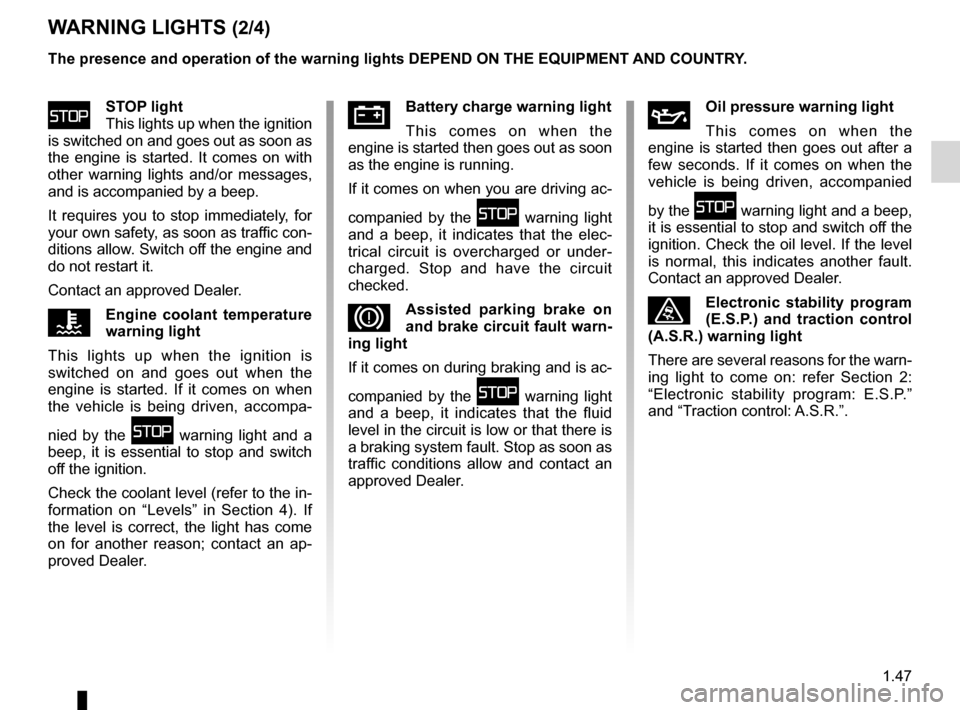
ASR (traction control) ............................................ (current page)
ESP: Electronic Stability Program ......................... (current page)
parking brake ......................................................... (current page)
engine oil ............................................................... (current page)
JauneNoirNoir texte
1.47
ENG_UD20346_1
Tableau de bord : témoins lumineux (X81 - J81 - Renault)
ENG_NU_932-3_X81ph3_Renault_1
WarnInG LIGHTs (2/4)
ûsTOP light
This lights up when the ignition
is switched on and goes out as soon as
the engine is started. It comes on with
other warning lights and/or messages,
and is accompanied by a beep.
It requires you to stop immediately, for
your own safety, as soon as traffic con-
ditions allow. Switch off the engine and
do not restart it.
Contact an approved Dealer.
Ôe ngine coolant temperature
warning light
This lights up when the ignition is
switched on and goes out when the
engine is started. If it comes on when
the vehicle is being driven, accompa -
nied by the
û warning light and a
beep, it is essential to stop and switch
off the ignition.
Check the coolant level (refer to the in-
formation on “Levels” in Section 4). If
the level is correct, the light has come
on for another reason; contact an ap -
proved Dealer.
ÀOil pressure warning light
This comes on when the
engine is started then goes out after a
few seconds. If it comes on when the
vehicle is being driven, accompanied
by the
û warning light and a beep,
it is essential to stop and switch off the
ignition. Check the oil level. If the level
is normal, this indicates another fault.
Contact an approved Dealer.
ùe lectronic stability program
( e .s .P.) and traction control
(a.s.r.) warning light
There are several reasons for the warn-
ing light to come on: refer Section 2:
“Electronic stability program: E.S.P.”
and “Traction control: A.S.R.”.
ÚBattery charge warning light
This comes on when the
engine is started then goes out as soon
as the engine is running.
If it comes on when you are driving ac-
companied by the
û warning light
and a beep, it indicates that the elec -
trical circuit is overcharged or under -
charged. Stop and have the circuit
checked.
Da ssisted parking brake on
and brake circuit fault warn-
ing light
If it comes on during braking and is ac-
companied by the
û warning light
and a beep, it indicates that the fluid
level in the circuit is low or that there is
a braking system fault. Stop as soon as
traffic conditions allow and contact an
approved Dealer.
The presence and operation of the warning lights dePend On THe eQUIPMenT
and cOUnTrY.
Page 54 of 267
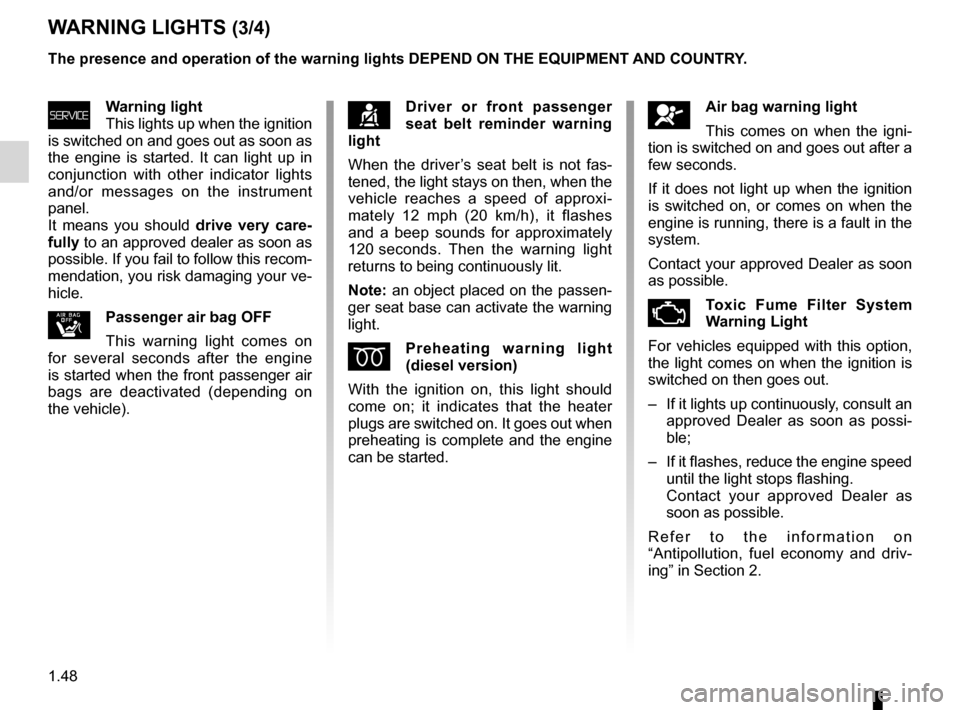
seat belts ............................................................... (current page)
speed limiter .......................................................... (current page)
cruise control ......................................................... (current page)
ABS ....................................................................... (current page)
air bag .................................................................... (current page)
1.48
ENG_UD20346_1
Tableau de bord : témoins lumineux (X81 - J81 - Renault)
ENG_NU_932-3_X81ph3_Renault_1
Jaune NoirNoir texte
WarnInG LIGHTs (3/4)
çdriver or front passenger
seat belt reminder warning
light
When the driver’s seat belt is not fas -
tened, the light stays on then, when the
vehicle reaches a speed of approxi -
mately 12 mph (20 km/h), it flashes
and a beep sounds for approximately
120 seconds. Then the warning light
returns to being continuously lit.
note: an object placed on the passen-
ger seat base can activate the warning
light.
ÉPreheating warning light
(diesel version)
With the ignition on, this light should
come on; it indicates that the heater
plugs are switched on. It goes out when
preheating is complete and the engine
can be started.
åair bag warning light
This comes on when the igni -
tion is switched on and goes out after a
few seconds.
If it does not light up when the ignition
is switched on, or comes on when the
engine is running, there is a fault in the
system.
Contact your approved Dealer as soon
as possible.
ÄToxic fume filter system
Warning Light
For vehicles equipped with this option,
the light comes on when the ignition is
switched on then goes out.
– If it lights up continuously, consult an
approved Dealer as soon as possi -
ble;
– If it flashes, reduce the engine speed
until the light stops flashing.
Contact your approved Dealer as
soon as possible.
R e f e r t o t h e i n f o r m a t i o n o n
“Antipollution, fuel economy and driv -
ing” in Section 2.
úWarning light
This lights up when the ignition
is switched on and goes out as soon as
the engine is started. It can light up in
conjunction with other indicator lights
and/or messages on the instrument
panel.
It means you should drive very care-
fully to an approved dealer as soon as
possible. If you fail to follow this recom-
mendation, you risk damaging your ve-
hicle.
ãPassenger air bag Off
This warning light comes on
for several seconds after the engine
is started when the front passenger air
bags are deactivated (depending on
the vehicle). The presence and operation of the warning lights dePend On THe eQUIPMenT and cOUnTrY.
Page 67 of 267
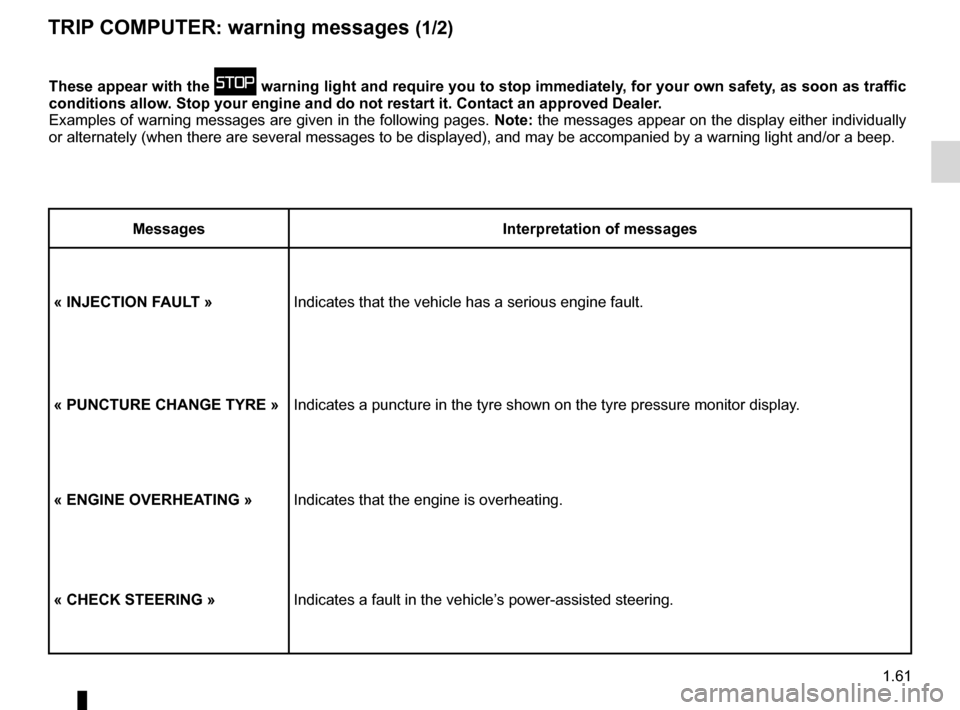
1.61
ENG_UD24102_1
Ordinateur de bord : messages d’alerte (X81 - J81 - Renault)
ENG_NU_932-3_X81ph3_Renault_1
TrIP cOMPUTer: warning messages (1/2)
These appear with the û warning light and require you to stop immediately, for your own safety, as soon as traffic
conditions allow. stop your engine and do not restart it. contact an approved dealer.
Examples of warning messages are given in the following pages. note: the messages appear on the display either individually
or alternately (when there are several messages to be displayed), and \
may be accompanied by a warning light and/or a beep.
Messages Interpretation of messages
« InJecTIOn faULT » Indicates that the vehicle has a serious engine fault.
« PUncTUre cHanGe TYre »Indicates a puncture in the tyre shown on the tyre pressure monitor disp\
lay.
« enGIne OVerHea TInG »Indicates that the engine is overheating.
« cHecK sTeerInG » Indicates a fault in the vehicle’s power-assisted steering.
Page 68 of 267
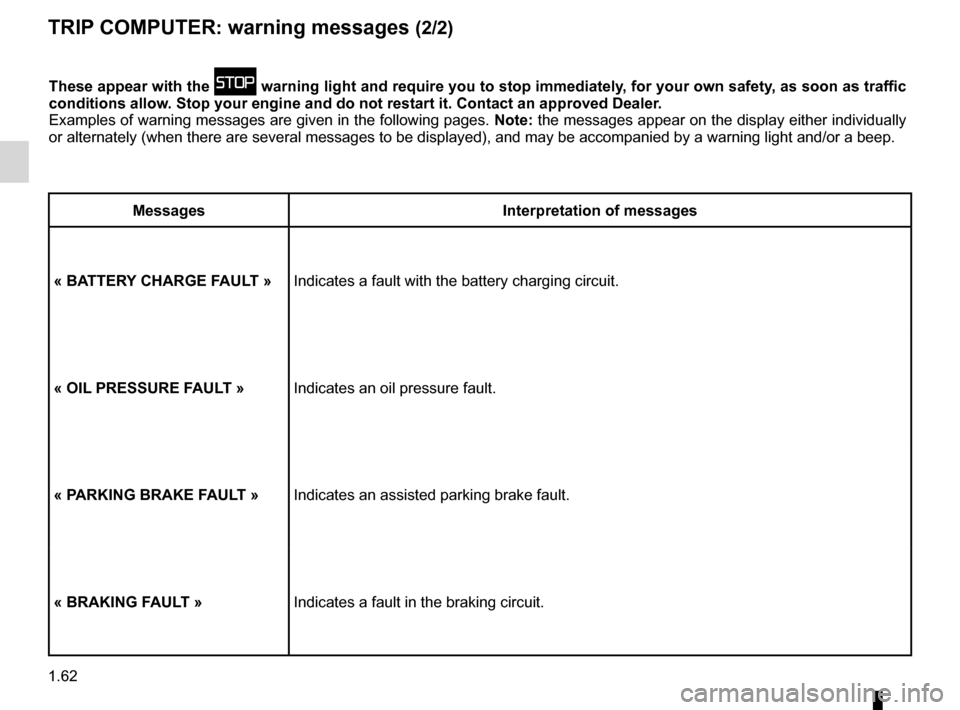
1.62
ENG_UD24102_1
Ordinateur de bord : messages d’alerte (X81 - J81 - Renault)
ENG_NU_932-3_X81ph3_Renault_1
These appear with the û warning light and require you to stop immediately, for your own safety, as soon as traffic
conditions allow. stop your engine and do not restart it. contact an approved dealer.
Examples of warning messages are given in the following pages. note: the messages appear on the display either individually
or alternately (when there are several messages to be displayed), and \
may be accompanied by a warning light and/or a beep.
Messages Interpretation of messages
« Ba TTer Y cHarGe faULT » Indicates a fault with the battery charging circuit.
« OIL PressUre faULT » Indicates an oil pressure fault.
« P arKInG BraKe faULT » Indicates an assisted parking brake fault.
« BraKInG faULT » Indicates a fault in the braking circuit.
TrIP cOMPUTer: warning messages (2/2)
Page 73 of 267

lights:dipped beam headlights ................................... (current page)
lights: side lights ......................................................... (current page)
1.67
ENG_UD20353_1
Eclairage et signalisation extérieure (X81 - J81 - Renault)
ENG_NU_932-3_X81ph3_Renault_1
Lighting and exterior signals
eXTerIOr LIGHTInG and sIGnaLs (1/3)
kdipped beam
headlights
automatic operation
With the engine running, the dipped
beam headlights are switched on or off
automatically depending on the level of
ambient light, without the need to oper-
ate stalk 1 (position 0).
This function can be deactivated or re-
activated.
– To deactivate it, with the ignition
on and engine switched off , turn
stalk 1 twice consecutively from po -
sition 0 to side lights. This action is
confirmed by an audible signal.
– To activate it, with the ignition
switched on and engine running or
off, turn stalk 1 twice consecutively
from position 0 to side lights. This
action is confirmed by an audible
signal.
– To select the main beam headlights,
pull stalk 1 towards you. To return to
the dipped beam headlight position,
pull the stalk towards you again.
– The lights go out when the engine
is stopped, when the driver’s door is
opened or when the vehicle is locked
with the RENAULT card.
Manual operation
Turn the end of stalk 1 until the symbol
is opposite mark 3.
An indicator light lights up on the instru-
ment panel in all cases.
daytime running lights
The daytime running lights come on
when the engine is started if stalk 1 is
in position 0.
If the dipped beam headlights oper -
ate automatically, the daytime running
lights only come on if the side lights are
off
1
2
1
3
uside lights
Turn the end of stalk 1 until the
symbol is opposite mark 3.
The instrument panel lights up, the
brightness can be adjusted by using
control knob 2.